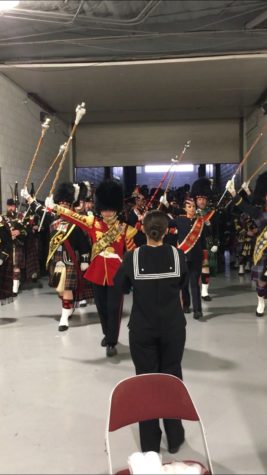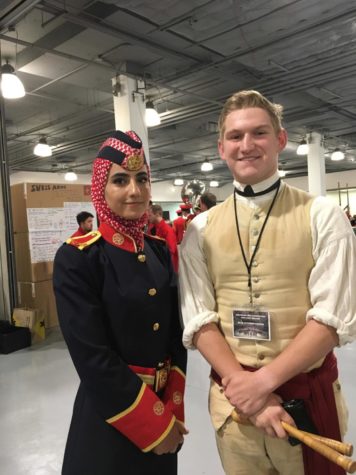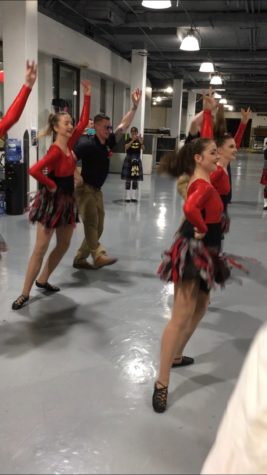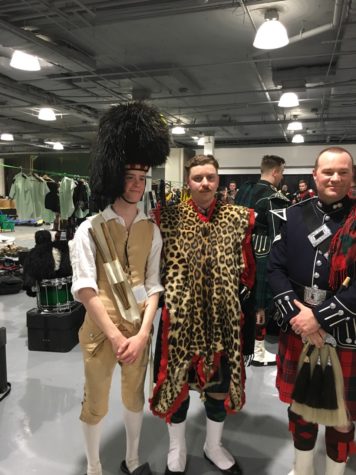Experiencing the 2019 Virginia International Tattoo
The nation’s biggest performance of its kind, as described by a cast member
Members of the U.S. Marine Corps Band , U.S. Air Force Heritage of America Band, and Jordanian Armed Forces Combined Pipe Band play on Colonial Williamsburg drums between shows, trying to get used to the different style of instrument

Assorted Drum Majors or the Virginia International Tattoo lead their groups out of the audience’s view during the show’s finale.
For four days each year, the area around Norfolk’s scope arena is flooded with performers from around the globe. They mill about in a sea of tartan, camouflage, and color, each bringing with them their culture and talents to perform as a part of the Virginia International Tattoo, a 22-year old tradition that serves as the signature event for the annual Virginia Arts Festival. Its 1,000+ member cast makes the event the largest of its kind in the United States, garnering over 38,000 attendees over its four-day length each year.
This year, the event was themed to honor the centennial anniversary of women being officially allowed into the American military, after which 30,000 women volunteered to serve, in numerous capacities, during the final stages of the First World War. 25 groups from eight different countries took part in the 6 shows (and one dress rehearsal, open to local children with special needs), which were the culmination of months, and, in some cases, years, of preparation and hard work. The groups which participated in this performance (as those included typically vary from year to year) included the 2 Canadian Mechanized Brigade, 4th Canadian Division Massed Pipes and Drums, Canadian Forces Base Trenton 8 Wing Pipes and Drums, and the Royal Canadian Air Force Pipes and Drums, all from Canada; the Pipes and Drums of the Highlanders, 4th Battalion, Royal Regiment of Scotland, from the United Kingdom; the French Army Signals Band and XV du Pacifique Rugby Team from France; the Swiss Army Central Band from Switzerland; the 30th Guard Brigade Drill Team from Romania, the Jordanian Armed Forces Combined Pipe Band from the Hashemite Kingdom of Jordan; the OzScot Irish Dance group from Australia; and the Granby High School Naval Junior Reserve Officer Training Corps (JROTC), the Hampton Roads Police Color Guards, the Headquarters Supreme Allied Command Transformation Multinational Ceremonial Detail (of NATO), the Norfolk Public Schools All-City High School Chorus, the Tidewater Pipes and Drums, the U.S. Air Force Heritage of America Band, the U.S. Army Drill Team, the U.S. Army Training and Doctrine Command Herald Trumpets, the U.S. Marine Corps Band (of Quantico), a U.S. Marine Corps FAST Company, the U.S. Navy Fleet Forces Band, the Virginia Symphony Orchestra Chorus, individual performer Andrew Carlisle, and Williamsburg’s own Colonial Williamsburg Fifes and Drums Corps, all from the United States.

A Colonial Williamsburg drummer, poses with a Jordanian drummer that he had met during the show.
Each show lasts approximately 2 hours, consisting of short performances by each group book-ended by opening and finale ceremonies which, together, account for about a quarter of the show’s run time. Before and between performances, the plaza outside the scope plays host to a number of additional events, including the Tattoo’s Drumline Battle, the Highland Heavy Athletic Championship, the Virginia International Tattoo American Pipe Band Championship, the Norfolk NATO Festival and accompanying Parade of Nations, and the Norfolk NATO Festival Flag Raising. Between the tattoo’s events and all of the opportunities at the nearby MacArthur Center and Norva, there are plenty of ways to keep even the most easily-bored people entertained for hours on end.

Marines present for the show attempt to learn the OzScot dancers’ performance.
Behind the scenes of the tattoo, it is a scene of controlled chaos and constant noise. The spaces underneath the Scope Arena are constantly occupied by performers cycling in and out for about 18 hours every day for an entire week, with three days set aside for practice and rehearsal and four days dedicated solely to the performances. Spread between the folding tables delegated to each group are contraptions designed purely by individual innovation, designed to do everything from holding uniforms to storing instruments. Performers mill about, talking, trading, and playing with one another in an area where the only thing that seems to not be present is quiet. Others wander about outside, some in full regalia, and some who have changed to better blend in with the crowd. One member of the Colonial Williamsburg Fifes and Drums, Sydney Harris, described it as a “once in a lifetime opportunity” that she is “never going to forget.” Another performer, United States Marine Nick Fiore, said “the International Tattoo was never something that I thought I would get a chance to, or even want to experience, but I can already tell how much I’m going to miss it – I’ve made some amazing friends here and I hope that I’ll get a chance to come back.”

A Colonial Williamsburg drummer borrows his newfound friend’s hat for a photograph; showing the camaraderie of the event.
Despite how different these people are, how different their cultures are, they become some of each other’s best and closest friends, who, after only seven days, might as well have known each other for their entire lives.




